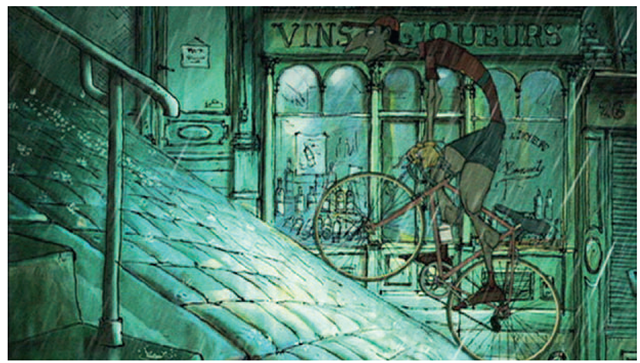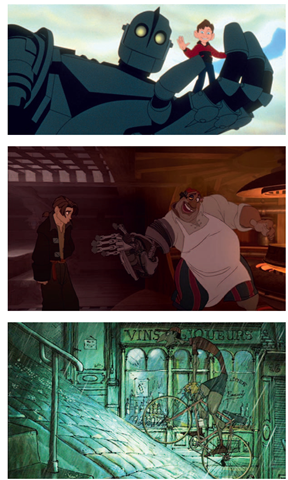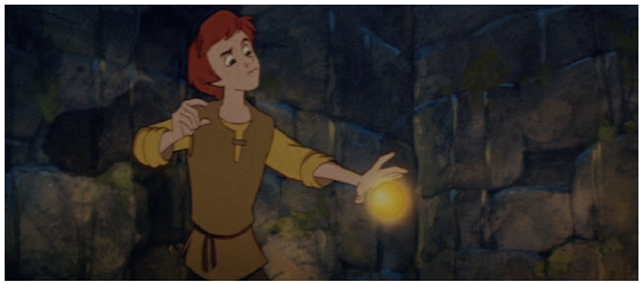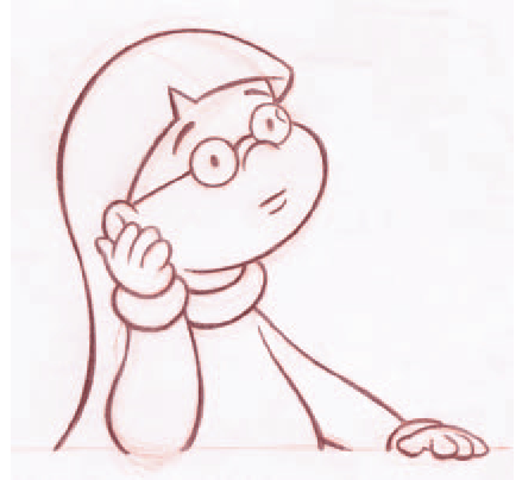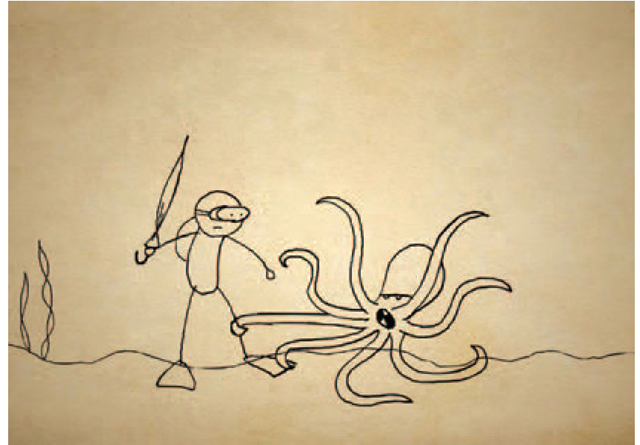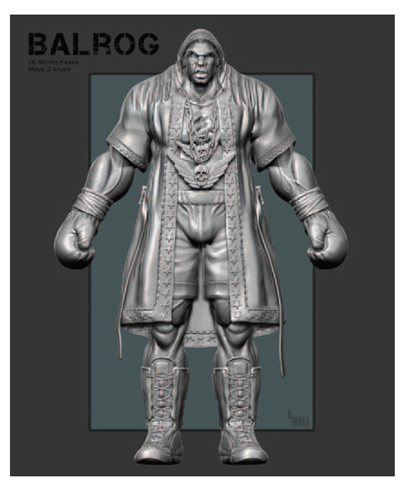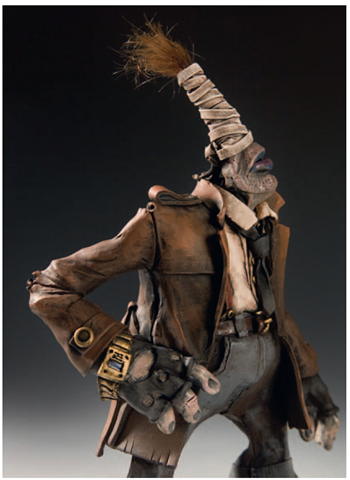Summary
What is 2D/3D animation? Why use one medium over another? What is the main problem of combining media, and how does one judge the success of this integration? This topic addresses all of these topics.
To begin your journey toward creating 2D/3D animation, the hands-on exercise section of this topic will have you create a short storyboard sequence using a given visual style, visual storytelling rules, and storybeats/beads. A short overview of using these three concepts is presented for those unfamiliar with the terms. Then, looking at the outcome of your exercise, we will contemplate what media might be used to execute the story.
FIGURE 1.1, FIGURE 1.2, FIGURE 1.3 Hybrid or 2D/3D animation examples can be found in many films, such as Iron Giant, Triplets of Belleville, and Treasure Planet.
What is Hybrid animation?
Hybrid animation is the combination of two-dimensional (2D) and three-dimensional (3D) animation media. 2D and 3D animation media can be used, and are used, independently of one another. Pixar’s The Incredibles is an entirely 3D animated film. Disney’s Dumbo is an entirely 2D animated film.
Yet ever since the first appearance of a 3D glowing bauble in a 2D animated film, Disney’s The Black Cauldron, artists have been finding inventive ways to combine the animation media. The use of 2D/3D at Disney predates The Black Cauldron and can be seen in a short test done by John Lassiter titled Where the Wild Things Are (1983).
FIGURE 1.4 The bauble from Disney’s The Black Cauldron was one of the first 3D elements to be combined with 2D animation.
Trench Note
Most attribute the first 3D element in a 2D animated film to the clock gears in Disney’s The Great Mouse Detective. The first experiments with combining 3D with 2D in a feature animated film is the bauble in The Black Cauldron, animated by Barry Cook.
There have been many combinations of media. Some of the earlier examples can be found in the Academy Award-nominated short Technological Threat in 1998 and also in a wonderful short film produced at Disney’s Florida studio called Off His Rockers. Both of these shorts can be found on YouTube. In feature animated films, probably one of the most memorable combinations of media is found in Warner Brother’s Iron Giant where a young boy befriends an alien robot, the robot being 3D in a 2D animated film. However, characters themselves do not need to be completely rendered in one medium or another, as was the case with the character John Silver in Disney’s Treasure Planet or the bicyclists in The Triplets of Belleville, as shown in Figures 1.1 through 1.3. In those films, 2D characters were drawn with 3D appendages rendered to match the 2D portions. Lastly, the most common use of combining media is for noncharacter animation assets or elements. This combination of 3D elements into 2D animation is seen in everything from Disney’s Mulan to The Simpsons Movie.
To begin with, let’s clarify exactly what 2D and 3D animation assets are and how they are created. You might be proficient with a few of these creation methods. The hope is that during the course of this topic, you will find yourself experimenting with other methods. A large, looming goal of this topic is to show you the path to fearlessness and flexibility with software.
2D animation assets are images that exist only in two dimensions during creation. There is nothing earth-shattering in that statement. How the 2D images are created is the interesting part. These images can be created in the birth tradition of animation using pencil and paper. In Figure 1.5, you see two artists’ work. One artist animated the character in red pencil on traditional paper. Then another artist drew a cleaned-up graphite version on a separate piece of paper. Both images are shown composited together in Figure 1.5. Also, traditional animation artists have had great success in creating their images digitally using software such as Photoshop, Flash, or Animo, to name a few. The character depicted in Figure 1.6 is a 2D character drawn and animated directly in Flash. Other ways of creating 2D animation images include painting on glass, drawing in sand, scratching on film, or using other flat methods of creation. All of these methods fall under the 2D animation category.
Take Note
I found these terms for 2D and 3D art: "flaties" and "clumpies."
I have not heard these terms used in the United States; perhaps they are used in the United Kingdom? Keep your ear out for these expressions. [Taylor p. 22]
3D animation assets exist in three dimensions during the creation process. Perhaps this is another not-so-earth-shattering statement, but look at the key phrase: during the creation process. Live-action film would come under this category, if we were not limiting ourselves to animation assets. 3D animation assets include digital and stop-motion animation. Digital animation can be created in 3D software packages such as XSI, Maya, Max, or a multitude of others. See the example of a 3D model in Figure 1.7. Stop motion is the process of animating tangible items in front of a camera; usually pose-able puppets made of clay, latex, or other materials. Figure 1.8 presents an example of a stop-motion character created by M.T. Maloney for his stop-motion short film King Rust.
FIGURE 1.5 2D Traditional Character “M.E." Animation (red)
FIGURE 1.6 Image from How to Throw a Jellyfish Party, drawn and animated in Flash
Because we are focusing on animation and not live action, combining film or video with 2D or 3D animation is beyond the scope of this topic. However, the same problem-solving concepts and compositing techniques covered in this topic can be applied to combining live action and animation.
Why Use One Medium Over the Other?
Artists’ imaginations continue to grow and stretch the boundaries of animation to tell stories. It can become difficult to decide which medium is best to tell the story. Sometimes, fad decisions are made based on the newness of a medium.
To take an objective look at the decision, consider the following five issues to determine why one medium might be preferred over another:
1. Visual target, not subject matter
2. Line mileage
3. Complexity
4. Team skills versus production schedule
5. Physical assets and budget
FIGURE 1.7 3D character modeled.
FIGURE 1.8 Character from the stop-motion animated film King Rust.
